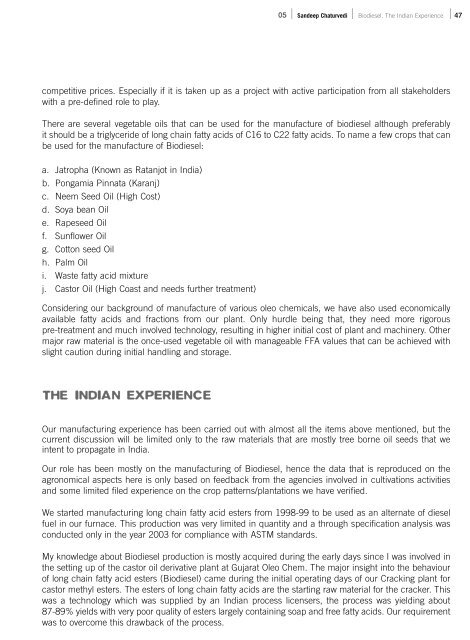Llibro_ISF_biodiesel
Llibro_ISF_biodiesel
Llibro_ISF_biodiesel
Create successful ePaper yourself
Turn your PDF publications into a flip-book with our unique Google optimized e-Paper software.
competitive prices. Especially if it is taken up as a project with active participation from all stakeholders<br />
with a pre-defined role to play.<br />
There are several vegetable oils that can be used for the manufacture of <strong>biodiesel</strong> although preferably<br />
it should be a triglyceride of long chain fatty acids of C16 to C22 fatty acids. To name a few crops that can<br />
be used for the manufacture of Biodiesel:<br />
a. Jatropha (Known as Ratanjot in India)<br />
b. Pongamia Pinnata (Karanj)<br />
c. Neem Seed Oil (High Cost)<br />
d. Soya bean Oil<br />
e. Rapeseed Oil<br />
f. Sunflower Oil<br />
g. Cotton seed Oil<br />
h. Palm Oil<br />
i. Waste fatty acid mixture<br />
j. Castor Oil (High Coast and needs further treatment)<br />
Considering our background of manufacture of various oleo chemicals, we have also used economically<br />
available fatty acids and fractions from our plant. Only hurdle being that, they need more rigorous<br />
pre-treatment and much involved technology, resulting in higher initial cost of plant and machinery. Other<br />
major raw material is the once-used vegetable oil with manageable FFA values that can be achieved with<br />
slight caution during initial handling and storage.<br />
THE INDIAN EXPERIENCE<br />
05 | Sandeep Chaturvedi | Biodiesel. The Indian Experience | 47<br />
Our manufacturing experience has been carried out with almost all the items above mentioned, but the<br />
current discussion will be limited only to the raw materials that are mostly tree borne oil seeds that we<br />
intent to propagate in India.<br />
Our role has been mostly on the manufacturing of Biodiesel, hence the data that is reproduced on the<br />
agronomical aspects here is only based on feedback from the agencies involved in cultivations activities<br />
and some limited filed experience on the crop patterns/plantations we have verified.<br />
We started manufacturing long chain fatty acid esters from 1998-99 to be used as an alternate of diesel<br />
fuel in our furnace. This production was very limited in quantity and a through specification analysis was<br />
conducted only in the year 2003 for compliance with ASTM standards.<br />
My knowledge about Biodiesel production is mostly acquired during the early days since I was involved in<br />
the setting up of the castor oil derivative plant at Gujarat Oleo Chem. The major insight into the behaviour<br />
of long chain fatty acid esters (Biodiesel) came during the initial operating days of our Cracking plant for<br />
castor methyl esters. The esters of long chain fatty acids are the starting raw material for the cracker. This<br />
was a technology which was supplied by an Indian process licensers, the process was yielding about<br />
87-89% yields with very poor quality of esters largely containing soap and free fatty acids. Our requirement<br />
was to overcome this drawback of the process.


